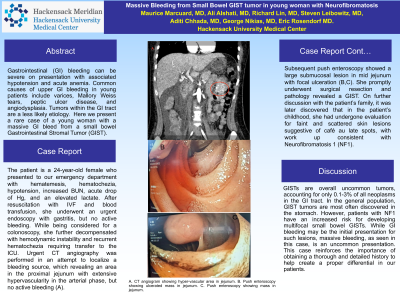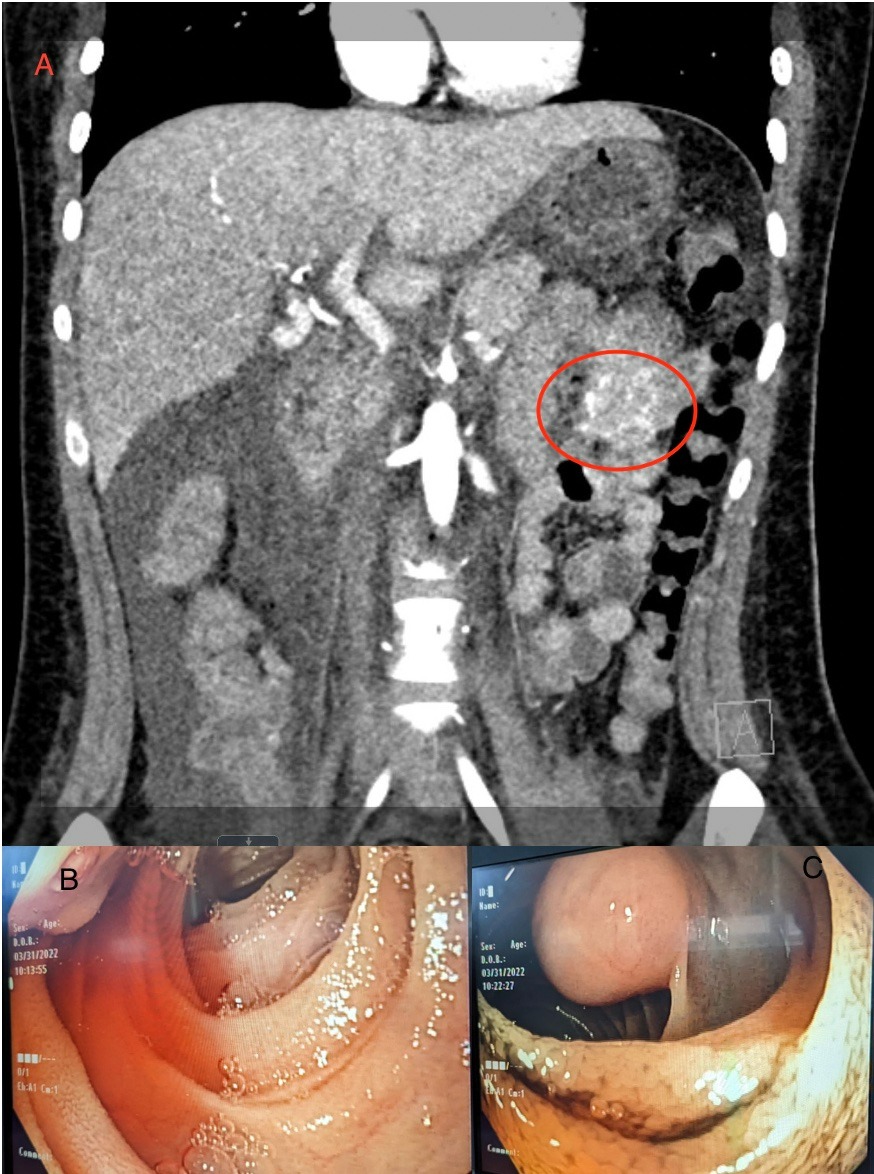Back


Poster Session D - Tuesday Morning
Category: GI Bleeding
D0329 - Massive Bleeding From Small Bowel GIST Tumor in Young Woman With Neurofibromatosis
Tuesday, October 25, 2022
10:00 AM – 12:00 PM ET
Location: Crown Ballroom

Has Audio

Maurice Marcuard, MD
Hackensack University Medical Center
Hackensack, NJ
Presenting Author(s)
Maurice Marcuard, MD1, Ali Alshati, MD1, Richard Lin, MD2, Steven Leibowitz, MD2, Aditi Chhada, MD2, George Nikias, MD2, Eric Rosendorf, MD2
1Hackensack University Medical Center, Hackensack, NJ; 2Hackensack University Medical Center, River Edge, NJ
Introduction: Gastrointestinal (GI) bleeding can be severe on presentation with associated hypotension and acute anemia. Common causes of upper GI bleeding in young patients include varices, Mallory Weiss tears, peptic ulcer disease, and angiodysplasia. Tumors within the GI tract are a less likely etiology. Here we present a rare case of a young woman with a massive GI bleed from a small bowel Gastrointestinal Stromal Tumor (GIST).
Case Description/Methods: The patient is a 24-year-old female who presented to our emergency department with hematemesis, hematochezia, hypotension, increased BUN, acute drop of Hg, and an elevated lactate. After resuscitation with IVF and blood transfusion, she underwent an urgent endoscopy with gastritis, but no active bleeding. While being considered for a colonoscopy, she further decompensated with hemodynamic instability and recurrent hematochezia requiring transfer to the ICU. Urgent CT angiography was performed in an attempt to localize a bleeding source, which revealing an area in the proximal jejunum with extensive hypervascularity in the arterial phase, but no active bleeding (A). Subsequent push enteroscopy showed a large submucosal lesion in mid jejunum with focal ulceration (B,C). She promptly underwent surgical resection and pathology revealed a GIST. On further discussion with the patient’s family, it was later discovered that in the patient’s childhood, she had undergone evaluation for faint and scattered skin lesions suggestive of café au late spots, with work up consistent with Neurofibromatosis 1 (NF1).
Discussion: GISTs are overall uncommon tumors, accounting for only 0.1-3% of all neoplasms in the GI tract. In the general population, GIST tumors are most often discovered in the stomach. However, patients with NF1 have an increased risk for developing multifocal small bowel GISTs. While GI bleeding may be the initial presentation for such lesions, massive bleeding, as seen in this case, is an uncommon presentation. This case reinforces the importance of obtaining a thorough and detailed history to help create a proper differential in our patients.

Disclosures:
Maurice Marcuard, MD1, Ali Alshati, MD1, Richard Lin, MD2, Steven Leibowitz, MD2, Aditi Chhada, MD2, George Nikias, MD2, Eric Rosendorf, MD2. D0329 - Massive Bleeding From Small Bowel GIST Tumor in Young Woman With Neurofibromatosis, ACG 2022 Annual Scientific Meeting Abstracts. Charlotte, NC: American College of Gastroenterology.
1Hackensack University Medical Center, Hackensack, NJ; 2Hackensack University Medical Center, River Edge, NJ
Introduction: Gastrointestinal (GI) bleeding can be severe on presentation with associated hypotension and acute anemia. Common causes of upper GI bleeding in young patients include varices, Mallory Weiss tears, peptic ulcer disease, and angiodysplasia. Tumors within the GI tract are a less likely etiology. Here we present a rare case of a young woman with a massive GI bleed from a small bowel Gastrointestinal Stromal Tumor (GIST).
Case Description/Methods: The patient is a 24-year-old female who presented to our emergency department with hematemesis, hematochezia, hypotension, increased BUN, acute drop of Hg, and an elevated lactate. After resuscitation with IVF and blood transfusion, she underwent an urgent endoscopy with gastritis, but no active bleeding. While being considered for a colonoscopy, she further decompensated with hemodynamic instability and recurrent hematochezia requiring transfer to the ICU. Urgent CT angiography was performed in an attempt to localize a bleeding source, which revealing an area in the proximal jejunum with extensive hypervascularity in the arterial phase, but no active bleeding (A). Subsequent push enteroscopy showed a large submucosal lesion in mid jejunum with focal ulceration (B,C). She promptly underwent surgical resection and pathology revealed a GIST. On further discussion with the patient’s family, it was later discovered that in the patient’s childhood, she had undergone evaluation for faint and scattered skin lesions suggestive of café au late spots, with work up consistent with Neurofibromatosis 1 (NF1).
Discussion: GISTs are overall uncommon tumors, accounting for only 0.1-3% of all neoplasms in the GI tract. In the general population, GIST tumors are most often discovered in the stomach. However, patients with NF1 have an increased risk for developing multifocal small bowel GISTs. While GI bleeding may be the initial presentation for such lesions, massive bleeding, as seen in this case, is an uncommon presentation. This case reinforces the importance of obtaining a thorough and detailed history to help create a proper differential in our patients.

Figure: A. CT angiogram showing hyper-vascular area in jejunum. B. Push enteroscopy showing ulcerated mass in jejunum. C. Push enteroscopy showing mass in jejunum.
Disclosures:
Maurice Marcuard indicated no relevant financial relationships.
Ali Alshati indicated no relevant financial relationships.
Richard Lin indicated no relevant financial relationships.
Steven Leibowitz indicated no relevant financial relationships.
Aditi Chhada indicated no relevant financial relationships.
George Nikias indicated no relevant financial relationships.
Eric Rosendorf indicated no relevant financial relationships.
Maurice Marcuard, MD1, Ali Alshati, MD1, Richard Lin, MD2, Steven Leibowitz, MD2, Aditi Chhada, MD2, George Nikias, MD2, Eric Rosendorf, MD2. D0329 - Massive Bleeding From Small Bowel GIST Tumor in Young Woman With Neurofibromatosis, ACG 2022 Annual Scientific Meeting Abstracts. Charlotte, NC: American College of Gastroenterology.

